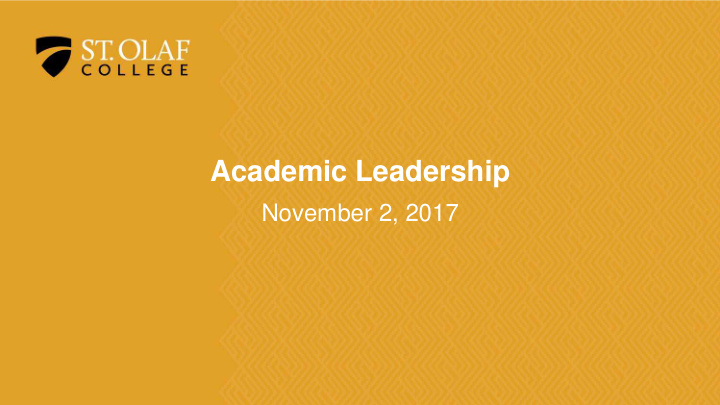



Academic Leadership November 2, 2017
SRAP Goals Develop a plan that includes: • Sufficient resources to support programs • Aligned revenue and expense growth • Competitive compensation packages • Commitment to capital enhancements • Contingency for unforeseen emergencies.
SRAP Principles • Demonstrate alignment with the College’s Mission and Mission in Practice Statements • Uphold the reputation and quality of the St. Olaf experience • Contribute to St. Olaf’s “value proposition” for students • Identify strategic opportunities or improvements • Continue development of the Strategic Plan
Activities To Date • Sept. 28 Academic Leadership Presentation • Oct. 5 Board of Regents Presentation • Oct. 10 SRAP Steering Committee Launch • Oct. 11 All Staff Meeting Presentation • Oct. 15 Instructional & Non-Instructional Committees Launch • Oct.- Dec. “SRAP Discussion Drop In” at various locations • Nov. 9 Faculty Meeting Presentation
(The) Bottom Line Matters We need to set the course of the budget to provide: • Salary increases and competitive pay/benefits • Sufficient contingency to meet an increasingly volatile enrollment environment • Investment in and improvement of buildings and other capital • Net revenue to build the endowment
Time Line (this may change some) • October/November: •Financial Aid Strategies developed •Distribute questionnaires and departments begin analyses • December/January: •Review groups work begins •Open Forums to present preliminary themes/ideas • February: •Depts/Programs finalize analyses for review group action •Board Update
Time Line (cont.) • March: •Review group recommendations developed •Open Forums to present recommendations • April/May: •Steering committee work to develop final recommendations •Final recommendations to be incorporated into FY18/19 budget planning •FY18/19 Preliminary Budget presented to Board of Regents
Steering Committee • VP/CFO – Jan Hanson • Provost/Dean of the College – Marci Sortor • Faculty Governance Committee Chair – Jill Dietz • Board of Regents Faculty Rep.-elect – Anne Walter • Asst. to the Pres. for Institutional Diversity – Bruce King • VP Mission – Jo Beld • SGA Rep. - Maren Weaver
Please Visit https://wp.stolaf.edu/treasurer/strategic- resource-allocation-project-srap/ For more information
A Few Framing Thoughts $ Academic Affairs makes up ~ 1/3 of the STO budget Has everything already been decided? (No.) Tell the truth…Isn’t the SRAP just about reductions? What about people’s jobs?
Non-Instructional Committee • Chief Information Officer of Libraries and IT (Chair) – Roberta Lembke • Athletic Director – Ryan Bowles • Piper Center Director – Leslie Moore • Director of Music Orgs – Jean Parish • Institute for College Futures faculty participant – Steve Freedberg • Associate Dean of Students – Tim Schroer • Budget Advisory Committee member - Cheri Floren • SGA Rep – Marit McQuaig
Non-Instructional Questionnaire •Designed to provide both qualitative and quantitative information •5 primary areas of focus : •Relationship of the Program to the Mission • Demand •Quality and Cost •Operational Analysis •Staffing •Due December 1 •Follow up face to face interviews with budget managers
Non-Instructional Questionnaire Tips •Focus on the core services your area provides and those things that are most valuable to the institution. •Use bullet points to maximize how much of your story you can tell. •Prioritize your list. •Ask your staff to help you fill out the form--the most creative ideas often come from the most surprising people!
Instructional Committee • Associate Provost (Chair) – Dan Dressen • FGC Rep. – Dan Hofrenning • Associate Deans – Kent McWilliams, Margaret O’Leary, Dana Gross, Mary Walczak, Beckie Judge • Registrar – Steve McKelvey • Budget Advisory Cmte. member - Steve Lindley • Dean of Students – Roz Eaton • SGA Representative – TBA
Strategic Resource Allocation Project Instructional Program Review Questionnaire
Guiding Principles • Demonstrate alignment with the College’s Mission and Mission in Practice statement • Uphold the reputation and quality of the St. Olaf experience • Contribute to St. Olaf’s “Value Proposition” for current and prospective students • Identify strategic opportunities or improvements • Continue development of the Strategic Plan
Category 1: Contribution to student learning Briefly comment on the evidence provided in your department or program’s data summary regarding your department or program’s contribution to student learning, the curriculum and high impact practices. (approximately 350 words)
Category2: Contribution to the work of the college not referenced in Category #1 Briefly comment on your department or program’s contributions to the work of the college that are not mentioned above in Category #1. Such comments might address contributions to the co-curriculum (i.e. performing arts, language houses), non-instructional programs (i.e. Natural Lands, library collections), special advising such as off-campus programs, and college governance and service (i.e. committees/task forces, placement exams, recruiting students). (approximately 250 words)
Category 3: Distinctive program features Address the following questions: a) How does your department or program advance the college mission in distinctive ways? (approximately 150 words) b) How is your department or program helping to advance increased diversity and inclusiveness among students, faculty and staff ? (approximately 150 words) c) How does your department or program advance any of the other guiding principles listed above?
Category 4: Program resources Briefly comment on the evidence provided in your department or program’s data summary regarding the resources provided to your department or program. (approximately 250 words)
Category 5: Opportunity analysis – Address any of the following questions as applicable: a) What existing plans, if any, are there to make changes to your department or program to improve quality, efficiency, and student experience in the future? (approximately 150 words) b) What is the potential for future development in or beyond your department or program? (approximately 150 words)
c) What initiatives could your department or program contribute to that would enhance the distinctiveness of St. Olaf College? (approximately 150 words) d) What initiatives could your department or program contribute to that would enhance revenues?
Category 6 : Is there anything else you think the Steering Committee should now about your department or program?
If you have suggestions for containing costs college-wide or that pertain to other departments/program, please go to the SRAP suggestion box at: https://wp.stolaf.edu/treasurer/suggestionbox/
Recommend
More recommend